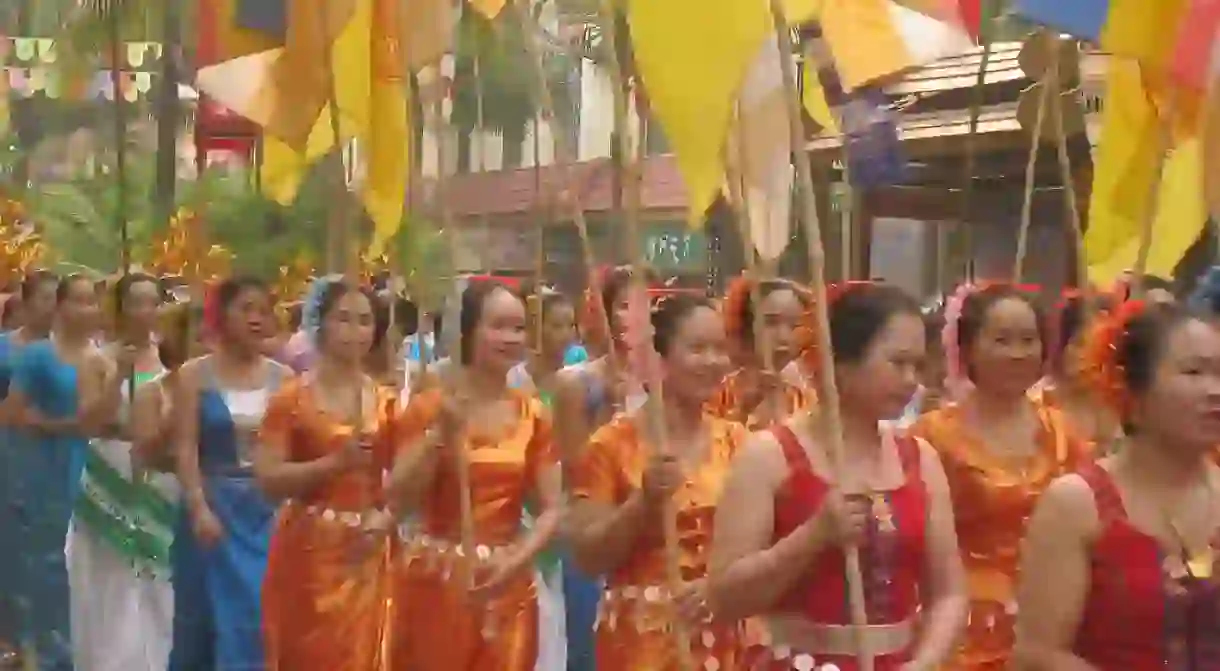An Introduction to China's Dai People

Similar to the Yao, the Dai is a composite of several related people groups. With a long history and a fun-loving culture, the Dai have come to influence Yunnan culture in a significant way.
One of China’s 55 officially recognized ethnic minorities, the Dai are closely related to both the Lao and Thai peoples, having a closely intertwined history and a relatively close geographical position. There are over one million Dai living in China, primarily in the southern Yunnan province; however, the largest cluster of Dai live in Myanmar, with an estimated 6.3 million. While Dai peoples all share a similar language and culture, the term is actually a generalization of several Tai-Kadai-speaking peoples in China’s south. To clear up confusion with the term, Thailand has come to call them Tai Lue, meaning Tai peoples in general.
Homeland
The vast majority of China’s Dai live in the Xishuangbanna Dai Autonomous Prefecture in the extreme south of Yunnan province. The prefecture borders Myanmar to the southwest and Laos to the southeast. With Dai culture dominating in Xishuangbanna, visitors to the region will feel much more like they have landed in Southeast Asia than in China. Harboring much of the biodiversity of Yunnan, Xishuangbanna is home to rainforests, rare plants and the last few Asian elephants in China.
Many Dai also live in Yunnan’s Dehong Dai and Jingpo Autonomous Prefecture, where coffee cultivation contributes greatly to the local economy.

History
Because Dai is an umbrella term created by China, it is difficult to pinpoint the exact origins of the people group. In fact, the term as such was not used until the founding of the People’s Republic of China in 1949, when the so-called “Water Dai,” “Land Dai,” and “Waist Festoon Dai” were merged into one Dai for census purposes.
According to the U.S. Library of Congress, the ancestors of the Dai, Thai, and Lao originate in what is now Yunnan, where they subsisted on lowland rice cultivation. Other scholars believe that the people group could even have diverged from early Pacific islanders. For centuries, the Dai lived in scattered villages governed under Muang, or principalities. Around the 10th and 11th centuries, they established powerful local kingdoms such as the Mong Mao and Kocambi, which dominated other ethnic groups in the region.
The first time the Dai were really ruled over by the Chinese was during the Yuan dynasty, when Mongol conquerors managed to capture as far south as modern day Myanmar. The subsequent dynasty, the Ming, pushed the Mongols out and began encroaching on Dai lands, producing a series of ongoing conflicts between the Dai and the Han Chinese that would come to a head in 1874 when a Hui Muslim named Du Wenxiu united the Dai with other minority groups in a rebellion against the Qing dynasty.
The Communists tried to make reparations with the Dai, establishing Xishuangbanna as an autonomous prefecture in the 1950s, but many Dai still faced persecution during the later Cultural Revolution and fled across the border to Dai communities in Thailand, Laos, Myanmar, and Vietnam.

Culture
Dai culture, like the people themselves, is vibrant and full of variety. One cultural aspect of note is the language, or rather, languages. The speaking of dialects and languages within the Tai-Kadai linguistic branch is one thing that helps unite the Dai. However, Dai in China still speak a wide range of languages, such as Tai Lu, Tai Nua, Tai Dam, Tai Ya, Tai Hongjin, and others. The Dai script is universal among these languages, however, and is quite different from Chinese in its adherence to an alphabetic system, likely derived from Sanskrit.
Many Dai in China celebrate the Water Splashing Festival during their New Year (April 13–16), a date chosen to honor the birthday of the Buddha. While today the festival seems to be little more than an excuse for kids to get out of school and squirt each other with water guns, its origins center around the ritual “bathing of the Buddha.” The festival is also widely celebrated in Thailand, where it goes by the name Songkran.

Cuisine
Though Yunnanese cuisine is a fusion of many local ethnic styles, a large part of it comes courtesy of the Dai. Yunnan cuisine uses all parts of nature. It is not uncommon to find locals chomping on insects, flowers, ferns, wild mushrooms, or algae, and those who are brave enough to try these culinary delights will find it a wonder that not everyone eats like that. The cuisine is often extremely spicy, although not in the same way that Sichuanese or Hunanese cuisine is spicy. Popular dishes include pineapple rice, mashed potatoes with chives and chilies and goat’s milk cheese.














